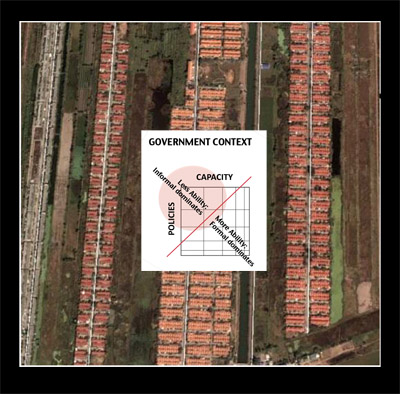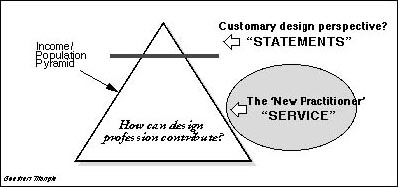 Third World urban population will double by 2020, and cities are projected to triple in area. To be more dramatic, all of the urban housing of the past 6,000 years needs to be built again, but this time in only 20 years! And now the issues of environment and climate add to the challenges.
Third World urban population will double by 2020, and cities are projected to triple in area. To be more dramatic, all of the urban housing of the past 6,000 years needs to be built again, but this time in only 20 years! And now the issues of environment and climate add to the challenges.
Data shows that 30% to 70% of housing in Third World cities is built informally, illegally, often in high-risk areas and without an understanding of basic construction knowledge. Do they dictate city development and form?
How will architects and planners as the spatial professionals participate in these challenges?
Click here to download
SIGUS research is focused in four areas:
- DESIGN AND PLANNING
This includes research on 'The Good Squatter' (since squatting - or quasi-legal development - is so common, how can it be directed toward a win-win end?); and Rapid ePlanning (how to approach the two key issues of today in the peripheral areas: speed and scale of development). -
DISSEMINATION OF INFORMATION
This includes development of participatory tools, and CD/internet sites of information. -
SUSTAINABILITY
Focus in part is on the key role of children, and research includes 'Children, Heritage and Development'. -
ROLE OF THE PROFESSIONAL
Where and how can architects and planners best contribute? How can their unique skills be utilized?

COMMUNITY ACTION PLANNING (MicroPlanning)
A Participatory Development Methodology by Reinhard Goethert and Nabeel Hamdi
Community Action Planning empowers communities to design, implement and manage their own settlement programs. Its methods are participatory, community-based, problem-driven, fast, and designed to inform policy from the grassroots. This approach was developed by Reinhard Goethert and Nabeel Hamdi during their collaborative work over the past 15 years. Their participatory approach catalyzed in Sri Lanka as part of the Million Houses Program, a national-scale participatory program internationally applauded. In Sri Lanka it was applied nation-wide and has become a model emulated in programs internationally.
The key element of Community Action Planning (CAP) is an active, intense community-based workshop, carried out over a period of 2 to 5 days, depending on the specific goals of the workshop. The output of the workshops is a development plan which includes a list of prioritized problems, strategies and options for dealing with the problems, and a rudimentary work program describing who, when and what is to be done. Integral to the method is the equal relation between the professional technical inputs and the community.
The set-up for the workshop requires a minimum of preparation, materials and training. Required is a motivated community and a confident moderator/facilitator/organizer who can take the lead in assuring that announcements are made, participants identified, a location selected, a few materials collected, and finally in running the workshop. Much of the preparation is done by the community. A designated person often takes responsibility for the logistics. Moderators need not be highly skilled and can adapt the style and content to suit their own temperament and the prevailing circumstances. Training of moderators/facilitators can be minimal, but is strongly advised to participate in an actual workshop in order that future moderators can capture the dynamics of the event as much as understand its procedures.
Materials required are limited to markers of some kind, large sheets of paper (any kind: wrapping paper, newsprint, cardboard, unfolded boxes), and a place for display of outputs.
The location should be in the community and accessible, rather than in government offices. Example locations have included formal classrooms to sitting on the ground with the back of a makeshift store as display space. This offers familiarity to participants, emphasizes the bias toward the community, and allows instant corroboration of issues.
The start to the process is problems definition. Both perceived those felt as being a problem and "real" problems those that are measurable are included without initial distinctions.
The process adopts four general stages of work:
- Stage 1: PROBLEM IDENTIFICATION and PRIORITIZING:
What are the problems? - Stage 2: STRATEGIES, OPTIONS and TRADEOFFS:
What approaches and actions are most suitable to deal with problems? - Stage 3: PLANNING FOR IMPLEMENTATION:
Who does what, when and how, and how to get it going? - Stage 4: MONITORING:
How is it working and what can we learn? (A variation of this stage is sometimes included in Stage 1 in identifying problems.)
At each stage charts structure the workshop and are completed by small mixed-background/mixed discipline groups during the workshop sessions. The charts are prepared on large pieces of paper for display purposes and with a minimum of formality to highlight the working nature of the sessions. They remain with the community as a record of discussions and agreements. At the conclusion, the community has a prioritized list of problems, a plan of action for implementation for key agreed options and an appointed person to liaison with authorities.
Participants at the workshop include a cross-section of community representatives, technical officers from the various departments (sanitation, water, housing, health, education, dependent on the nature of the municipality organization). The facilitator plays a key role as moderator and must have the confidence of all participants.
The original handbook explaining Community Action Planning (at that time called Microplanning) was prepared for the National Housing Development Authority of the Government of Sri Lanka and for its technical staff. The handbook was later expanded with the addition of a frontpiece on the conceptual background, a section describing the workshop dynamics in Santiago, Chile, and a section on assessing the impact one year after MicroPlanning workshops were held in four communities. A modified version was prepared as a "Training of Trainers" guide as part of the dissemination of the methodology throughout the country.
Subsequent to the development of the methodology in Sri Lanka, the approach has been used by the authors and others worldwide, in Bangladesh, South Africa, Boston (USA), Poland. It is being used extensively in Central America by the regional version of ILUA. It has not been successful in Boston because of the underlying political commitment required. There local authorities feared that the outcomes would not match official expectations, despite their funding of the preparation of a locally-oriented handbook. The methodology was selected by the World Bank's Economic Development Unit for its municipal programs throughout Latin America and translated into Spanish.
The process is flexible and variations of the approach with their explanatory handbooks have been prepared to address specific circumstances. In Bangladesh a version was prepared that linked training of local technical officers, participatory community upgrading, and the on-going strategic planning effort in Dhaka and Chittagong. In South Africa the method is being used as part of the township upgrading, and a pilot project was undertaken in Schweizer-Reneke, North-West Province, with subsequent workshops in the planning stages. Recently it has been adapted as a tool for risk mitigation by communities in India. In all cases where community action planning was used the fundamentals were retained: rapid, intense field-based workshops, a problem-driven agenda, equal community/technical participation and documentation.
Key Resources:
MAKING MICROPLANS: A COMMUNITY BASED PROCESS IN PROGRAMMING AND DEVELOPMENT. Reinhard Goethert and Nabeel Hamdi. IT Publications, 1988.
(Also available in Spanish as: LA MICROPLANIFICACIÓN: UN PROCESO DE PROGRAMACIÓN Y DESARROLLO CON BASE EN LA COMUNIDAD, Instituto de Desarrollo Económico del Banco Mundial, Documento Técnico del IDE, 1992.)
ACTION PLANNING FOR CITIES: A GUIDE TO COMMUNITY PRACTICES. Nabeel Hamdi and Reinhard Goethert, John Wiley & Sons, 1997.
Case Files in the book illustrate a variety of practical ways in which MicroPlanning maybe applied, with examples from Sri Lanka, South Africa, and Boston, USA. Note the flexibility and freedom in adjusting the specific items to suit the particular circumstances.
PLAN FOR ACTION WALL CHART. A large format chart (30"x40") which may be used as a guide for running workshops, a management tool in organizing, evaluating and arranging logistics for workshops, and as a training tool for practitioners. Available from SIGUS-MIT, Room 9-369, School of Architecture and Planning, MIT, Cambridge, MA. 02139. Or email: sigus@mit.edu.
Context of Research

- Research derived from reality of place
- Both 3rd World and 1st World issue
- Focus on pragmatic application
How develop awareness, appreciation and respect for built environment?
Representative Project: "Architecture Explorers"
Development of a teacher's guidebook for elementary schools. This initial phase develops and tests a model handbook through field trials with a Boston elementary school. The long-term goal is to develop an exportable Teacher's Kit for 3rd World heritage appreciation. Funding is from Boston Society of Architects.
How improve techniques of dialogue and interaction?
Representative Project: "Mozambique Distance Learning Pilot Initiatives"
Joint MIT-World Bank- University of Maputo exploratory studies in participatory design and development linked to city structural planning. Focus on three levels: community-community links, channels to link to city, and receptivity at structural planning level.
How link design with social and economic development?
Representative Project: "The Syria Dead Cities Heritage Corridor"
Rural development opportunities through linking historical preservation and eco-tourism at the village level. 1000 so-called "Dead Cities" provide the framework for the development. Project jointly developed with Aga Khan Program at MIT.
Research Topics of SIGUS Interest
Special assistance will be offered to students who focus on topics related to the interests of SIGUS. SIGUS provides guidance in formulating the thesis hypothesis, preparing an outline, structuring fieldwork and identifying local contacts, as well as advising on the report and/or thesis during its development. Contact sigus@mit.edu for discussion of topic in more detail. Although many of the interests are grouped by country, generally they may be applied to other contexts as well.
EL SALVADOR
"Comparison and Evaluation of Five Different Housing Prototypes Resulting from Divergent Perspectives by their NGO Funders". Studies targeting housing offered by the varied donors in their earthquake reconstruction programs.
"Evaluation of the Innovative 'Cluster' Type of Land Subdivision in Sensunapan vs Traditional Forms in Santa Ana". Comparing initial development goals of land subdivisions to their current state 20-years afterwards.
"Earthquake Resistance of Design and Structural Innovations in Low-cost Housing". Analyzing dwelling performance under various earthquake magnitudes.
EGYPT
Revisiting the legacy 'site and service' projects from the 1980s built by varied international development agencies. What worked, what lessons?
PERU
The 1967 PREVI competition in Lima. How did it turn out? What lessons may be learned?
KOSOVO
Study of the Informal sector rapidly growing on the outskirts of the larger cities, particularly Pristina.
GENERAL
"Shape Grammars: Children, Heritage and Design". Programs and methods that respect and build appreciation of architectural heritage through educational programs.
The 1976 Vancouver-Tondo competition in Manila.
Comparison of international housing competitions targeting low income. How effective where they? Is this a good model for innovation?
Rapid urban growth modeling through computer graphics. Development of simple dynamic growth model for practitioners and tested in various urban areas.

